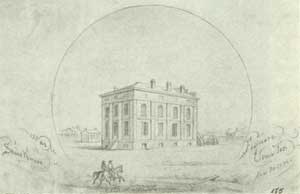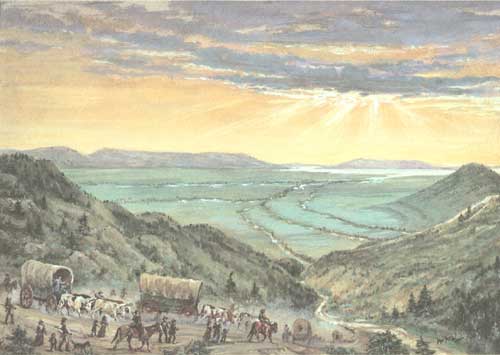
INTRODUCTION
By Marian Albright Schenk
FOREWORD
By Dean Knudsen
SECTION 1
Primary Themes of Jackson's Art
SECTION 2
Paintings of the Oregon Trail
SECTION 3
Historic Scenes From the West
 |
| For a man who spent his life climbing into the most remote corners of the North American continent, the Egyptian pyramids did not seem to pose much of a challenge. (SCBL 3112) |

Section 2: Paintings of the Oregon Trail
THE PROMISED LAND
William Henry Jackson arrived in Salt Lake City on October 18, 1866, by following the same route the Mormon Pioneers had used almost 20 years earlier. Unlike the Mormons, Jackson entered the Salt Lake Valley disillusioned and desperate. Five weeks earlier, he had decided to leave the freighting outfit and give up his dream of finding gold in Montana.1 Jackson's decision to quit his job was made near Fort Bridger, when he learned that the wagon boss intended to bypass Salt Lake City. Apparently the personal conflicts that had plagued the teamsters took their toll on Jackson and he was thinking about returning home. As Jackson later related it:
In a flash—and for no assignable reason, except that I thought it would be easier to return to the East from there, by way of San Francisco!—I decided to go to Salt Lake. Montana, goal of my dreams these many months, dissolved into thin air.2
Virtually penniless, Jackson spent the next two months in Salt Lake City, where he eked out a living working as a farm laborer. Providentially, Jackson's father sent him $100, which allowed Jackson to book passage with a wagon train bound for California. During his brief stay in Salt Lake City, the homesick young man considered the possibility of setting up a portrait studio, but his thoughts were still of the girl he had left behind. As he recorded in his journal:
Could I make money in any reasonable amount so that I could live here respectably, I should be very contented to remain here during the winter, & then go west in the spring. Writing that letter to Caddie gave me a real set of blues. . . O! how I wish & have wished that I only had some money ahead so that I might at once go to the states & be in a position to consummate every desire were everything else all favorable.3
 |
| A penciled note incorporated into this drawing reads, "State House at Fillmore, Utah Dec 30, 1866." (SCBL 175) |
The painting, "Salt Lake Valley" was completed 70 years after Jackson's first visit, and it depicts Mormon emigrants as they finally arrive at a place where they could look out over the valley that was to be their new home. In the distance, to the right, is the Great Salt Lake. This is substantially the same view Jackson would have had in 1866, except that by that time Salt Lake City had developed into a thriving community.
The wagon train winding its way past the foreground is entering what is known today as Emigration Canyon. Emigration Canyon is where Brigham Young, who was lying ill in a wagon, first saw the Salt Lake Valley. Despite the fact that the valley was basically an arid desert, Young turned to his fellow Mormons and is alleged to have said, "This is the Place!" This was the land that they would make into a new homeland.
1. Jackson, Time Exposure, 132-137.
2. Ibid., 133.
3. Hafen, Jackson Diaries, 95.
 |
| The Salt Lake Valley. Signed and undated. 24.2 x 34.3 cm. (SCBL 41) |
 |
scbl/knudsen/sec2s.htm Last Updated: 14-Apr-2006 |
 |